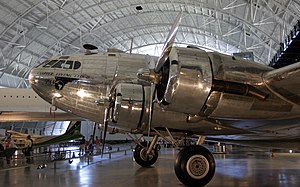Boeing 307
| Boeing 307 Stratoliner C-75 |
|
|---|---|
 |
|
| A restored (ex-PanAm) Boeing 307 on display at the Steven F. Udvar-Hazy Center | |
| Role | Airliner |
| Manufacturer | Boeing |
| First flight | 31 December 1938 |
| Introduction | 4 July 1940 with Pan American Airways |
| Retired | 1975 |
| Status | Retired |
| Primary users |
TWA Pan American Airways United States Army Air Forces |
| Number built | 10 |
| Unit cost |
$315,000 (in 1937 when ordered)
|
| Developed from | Boeing B-17 Flying Fortress |
The Boeing Model 307 Stratoliner was the first commercial transport aircraft to enter service with a pressurized cabin. This feature allowed the aircraft to cruise at an altitude of 20,000 ft (6,000 m), well above many weather disturbances. The pressure differential was 2.5 psi (17 kPa), so at 14,700 ft (4,480 m) the cabin air pressure was equivalent to an altitude of 8,000 ft (2,440 m). The Model 307 had capacity for a crew of six and 33 passengers. The cabin was nearly 12 ft (3.6 m) across. It was the first land-based aircraft to include a flight engineer as a crew member (several flying boats had included a flight engineer position earlier). In addition to its civilian service it was also flown as the Boeing C-75 Stratoliner by the United States Army Air Forces, who used it as a long-range cargolift aircraft.
In 1935 Boeing designed a four-engine airliner based on its B-17 heavy bomber (Boeing Model 299), then in development, calling it the Model 307. It combined the wings, tail, rudder, landing gear, and engines from their production B-17C with a new, circular cross-section fuselage of 138 in (351 cm) diameter, designed to allow pressurization.
The first order, for two 307s (named Stratoliners), was placed in 1937 by Pan American Airways; Pan Am soon increased this to six, and a second order for five from Transcontinental & Western Air (TWA), prompting Boeing to begin production on an initial batch of the airliner.
At the time the United States entered World War II in December 1941, flying across oceans was a rare luxury. The war required government and military officials to do so and most four-engined long-range commercial aircraft, including Pan American Airways' 14 flying boats and TWA's five Boeing 307s, were pressed into service. Additional fuel tanks were added to give them the extra range required; once converted they were designated C-75 for military use. Before World War II ended their production, ten commercial 307s had been built. TWA flew domestic routes between New York and Los Angeles for 18 months until the Army purchased their Stratoliners for wartime use as long-range, transatlantic transports for various VIPs or critical cargo. TWA converted their 307s to military service in January 1942, and its Intercontinental Division (ICD) then operated these C-75s under contract to the Army's Air Transport Command (ATC) until July 1944. These were the only U. S. built commercial aircraft able to cross the Atlantic with a payload until the arrival of the Douglas C-54 Skymaster in November 1942.
...
Wikipedia
